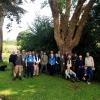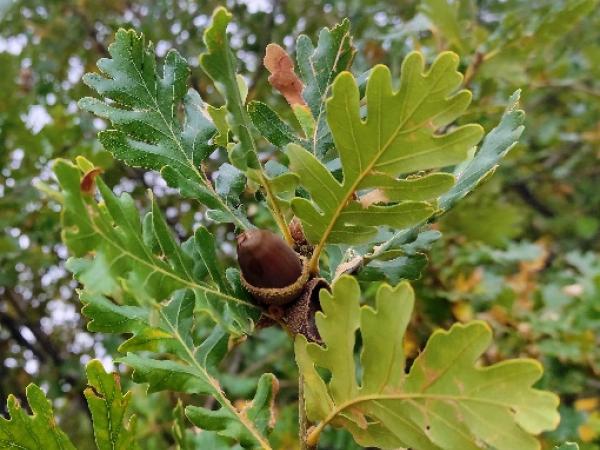Editor's Picks
Plant Focus
A natural hybrid between Quercus lyrata (overcup oak) and Q. virginiana (southern live oak), Q. ×comptoniae is found in southeastern USA, from Virginia to Texas, in the intersection of the distributions of the parent species. It is thus limited to coastal areas in the southeast (by Q. virginiana's range) and to the panhandle in Florida and to the eastern part of the state in Texas (by Q. lyrata's range). It can reach a height of 35 m and its form tends to be intermediate between those of its progenitors, usually more upright than southern live oak and more spreading than overcup oak. The bark on mature trees is deeply furrowed and scaly, but smoother when young. Leaves are semi-evergreen, oblanceolate with a wedge-shaped base and an acute or acuminate tip, the length ranging from 6 to 10 cm and the width from 3 to 4 cm. The foliage tends to be thicker than that of overcup oak, and not as much as southern live oak’s. The leaf margin is lobed in the upper half of the blade, with 3 or 4 shallow forward-pointing lobes, sometimes entire. The cupule encloses from a third to three quarters of the acorn, the scales are thin, broadly ovate, their tips free, forming a serrate rim or fringe to the cup. The inside of the cupule is pubescent (a characteristic of Q. virginiana, but not of Q. lyrata). Acorn shape is also intermediate: wider than southern live oak, but not as wide as overcup oak’s almost spherical acorns.

The reproductive barriers between sections usually admit impediment to the marriage of distantly related oaks. But in the case of Compton oak, as in some other rare instances, the barrier has been raised: Quercus virginiana is in Section Virentes and Q. lyrata in Section Quercus. Quercus virginiana has few known hybrids, all with Section Quercus oaks. Compton oak is the most well-known, but named hybrids also exist for the cross of Q. virginiana with Q. stellata (Q. ×harbisonii), Q. macrocarpa (Q. ×burnetensis), and Q. bicolor (Q. ×nessiana)—this last one artificial. The match with Q. lyrata is one made in horticultural heaven. Like other crossings between evergreen and deciduous oak species (e.g. Q. ×turneri and Q. ×crenata), one of its main attractions is the possibility of semi-persistent foliage for hardiness-challenged gardens. It is also quite the all-terrain tree: it is even more site-tolerant than southern live oak, inheriting from overcup oak the ability to grow just about anywhere, including hilltops, sandy soils, and sites with poor drainage. It is reported to display vigorous growth, as befits its hybrid nature, and to be drought tolerant. Its habit can be apically dominant, leading to attractive structure, or wide-spreading, providing ample shade. The intermediate forms are ideal for urban plantings, a trait which runs in the family.
The hybrid was first described in 1918 by Charles Sargent, though Sargent had previously described it, in part, in 1895, based on specimens collected in 1880 in Texas. In the earlier publication, Sargent had included the specimens under Q. lyrata, commenting they were the only acorns of this species he had seen with cups than enclosed only one-half or two-thirds of the cup. These Texas trees had apparently disappeared by 1918 and Sargent based his description on specimens from Mississippi, Alabama, and Louisiana, almost all of which had been planted but were thought to be from wild sources. His assumption that the oak was of hybrid origin was further borne out by the fact that similar plants had been raised artificially by Helge Ness at the Texas Agricultural Experiment Station. In 1948, E.J. Palmer included Compton oak in his article “Hybrids of North America”, describing it as “a handsome and ornamental tree of rapid growth [that] should be valuable in cultivation.” He reported that several seedlings had survived at the Arnold Arboretum in Massachusetts (USDA Zone 6b), even though southern live oak is not hardy there and overcup oak though hardy is far north of its native range. By then the hybrid had been found growing spontaneously at several locations.
Quercus ×comptoniae is highly spoken of in the nursery trade. Nativ Nurseries extols its fast growth and large, tasty acorns (the nursery specializes in trees planted to attract game). For the balanophagous Oikos Tree Crops the low tannin acorns are “delicious” and the tree’s hardiness is notable: they report it survives in their zone 5 nursery, though does not flourish, and is ideal for zones 6 and south. They also state it can be used for commercial shade tree farms as it is uniform from seed; this is contradicted by Nativ Nurseries, who point out that seedlings are very variable, an attractive feature for them as some trees may drop acorns in years when others don’t. Dave Muffly also comments on the variability of leaf fall and fall color amongst specimens of the hybrid.
Select Trees has taken a different approach and offers ‘Endurance’TM, the first clonal Compton Oak grown on its own root, a cultivar ideal for urban environments, displaying tolerance to many soil types as well as drought. The cultivar is not yet registered on the IOS’s Oak Names website, but according to Select Trees a patent has been applied for.
The most famous specimen of Compton oak grows at Colonial Williamsburg, Virginia, USA on the courthouse square. It is an impressive wide-spreading specimen, tending to the Q. virginiana parent in habit, though its canopy is not as wide as the great live oaks of the South.
Based on his recently discovered correspondence, Justin B. Brouwers, the first Landscape Superintendent for The Colonial Williamsburg Foundation, wrote that he located this tree in an area known as Boush Creek, South of Norfolk, Virginia in 1937. It was transplanted to its present location in 1938 (R. Brown pers. comm.). It is the largest known tree of this hybrid in the U.S. and was last featured in the Virginia Big Tree Project database in 2024, measuring 20.1 m high and 39.6 m wide, with a DBH of 176.3 cm. It would likely qualify as the National champion, but the current curator of that list, the University of Tennessee, no longer considers hybrids in their National Register of Champion Trees. The Virginia register now follows suit.
In the Citywide Arboretum in Aiken, South Carolina, IOS member Bob McCartney planted a couple of specimens deemed to be Q. ×comptoniae, selected from a lot of seed-grown Q. virginiana in a wholesale nursery, as well as one grown from an acorn from a Compton oak in Anniston, Alabama. True to his Southern heritage, Bob judges the hybrid specimens based on the degree to which they favor the live oak parent, describing F2 seedlings of the Colonial Williamsburg as “inferior” because they are more upright and favor the Q. lyrata parent. Better trees, in his view, were obtained from the Alabama-sourced tree, which is likely a backcross with Q. virginiana, and in a tree grafted from the Colonial Williamsburg tree (Bob McCartney, pers. comm.).This is in contrast to those who seek suitable street trees and prefer upright forms of the hybrid. David Richardson (pers. comm.) reports that most Compton oaks are upright and has found an such a form used successfully as street trees in Dallas, Texas.

Compton oaks from different sources planted in mid-Missouri (USDA Zone 6a) are proving to be perfectly hardy and have adapted to different soil conditions. They are typically semi-evergreen, holding green foliage until January or February; several of them have fruited (Ryan Russell, pers. comm.)
According to the Cultivated Oaks of the World database, specimens are grown in oak collections in the US and further afield, including Europe and Argentina, mostly of wild origin even if sourced from nurseries. A wide range of forms appears to be present in collections: trees at Starhill Forest Arboretum, grown from acorns from hybrid trees, are intermediate but seem to show affinity to Q. lyrata, whereas a specimen at the Iturraran Botanical Garden has many leaves with entire margins.

At Starhill (USDA Zone 5b), the trees appear to be at their hardiness limit: one of three trees from different wild sources has died, and while the other two survive, they do not appear to be happy in that climate (Guy Sternberg, pers. comm.).
A particularly notorious Compton oak caught the public’s attention in 2012 when it was moved, as a large, mature tree and at great expense, to save it from removal due to the construction of a highway in League City, Texas. Despite some challenges involving dieback and disease due to poor drainage, it appears to be in good shape. Transplantability seems to be another favorable trait of this remarkable hybrid!
Charles Sargent named the hybrid after a Miss C.C. Compton from Natchez, Mississippi, who aided him in obtaining specimens by locating some 20 or 30 trees near her home town and sending him material for study and acorns for cultivation. His original spelling of the epithet was “Comptonae”, but this was subsequently corrected to “comptoniae” in accordance with Article 60.8 of the International Code of Nomenclature for algae, fungi and plants. Miss Compton1 (1876-1944) was in fact Sargent’s namesake: her initials stand for Charles Cromartie.
Charles used to be more common as a girl’s name in the 19th century, but a relative has suggested that perhaps her masculine name helped give her a boost of courage 2 to take the lead in trying to save historic buildings and homes in Natchez and surrounding Adams County, the work she is most remembered for. The Historic Natchez Foundation instituted in 2019 the “Charlie Compton Historic Preservation Award” presented each year to the most outstanding preservationist in the Natchez area. She certainly seems to have earned the admiration of Sargent, who concluded his description of the hybrid with the following dedication:

Acknowledgments
I'd like to thank Bob McCartney, David Richardson, Ryan Russell, Ricklin Brown, and Francisco Garin for providing information for this article.
Updated April 4, 2025
1 Not to be confused with Henry Compton (1632-1713), Bishop of London, in whose honor the monotypic genus Comptonia was named.
2 Rather like—though with genders reversed—the case recounted in Shell Silverstein's song “A Boy Named Sue” (made famous by Johnny Cash)
Updated April 20, 2025 to reflect latest data from Virginia Big Tree Project.























